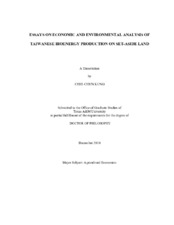| dc.description.abstract | Domestic production of bioenergy by utilizing set-aside land in Taiwan can reduce
Taiwan’s reliance on expensive and politically insecure foreign fossil fuels while also
reducing the combustion of fossil fuels, which emit substantial amounts of greenhouse
gases. After joining the World Trade Organization, Taiwan’s agricultural sector idled
about one-third of the national cropland, hereafter called “set-aside land”. This
potentially provides the land base for Taiwan to develop a bioenergy industry. This
dissertation examines Taiwan’s potential for bioenergy production using feedstocks
grown on set-aside land and discusses the consequent effects on Taiwan’s energy
security plus benefits and greenhouse gas (GHG) emissions.
The Taiwan Agricultural Sector Model (TASM) was used to simulate different
agricultural policies related to bioenergy production. To do this simulation the TASM
model was extended to include additional bioenergy production possibilities and GHG
accounting. We find that Taiwan’s bioenergy production portfolio depends on prices of
ethanol, electricity and GHG. When GHG prices go up, ethanol production decreases and electricity production increases because of the relatively stronger GHG offset power
of biopower.
Results from this pyrolysis study are then incorporated into the TASM model.
Biochar from pyrolysis can be used in two ways: burn it or use it as a soil amendment.
Considering both of these different uses of biochar, we examine bioenergy production
and GHG offset to see to what extent Taiwan gets energy security benefits from the
pyrolysis technology and how it contributes to climate change mitigation. Furthermore,
by examining ethanol, electricity and pyrolysis together in the same framework, we are
able to see how they affect each other under different GHG prices, coal prices and
ethanol prices. Results show that ethanol is driven out by pyrolysis-based electricity
when GHG price is high. We also find that when biochar is hauled back to the rice fields,
GHG emission reduction is higher than that when biochar is burned for electricity;
however, national electricity production is consequently higher when biochar is burned. | en |


